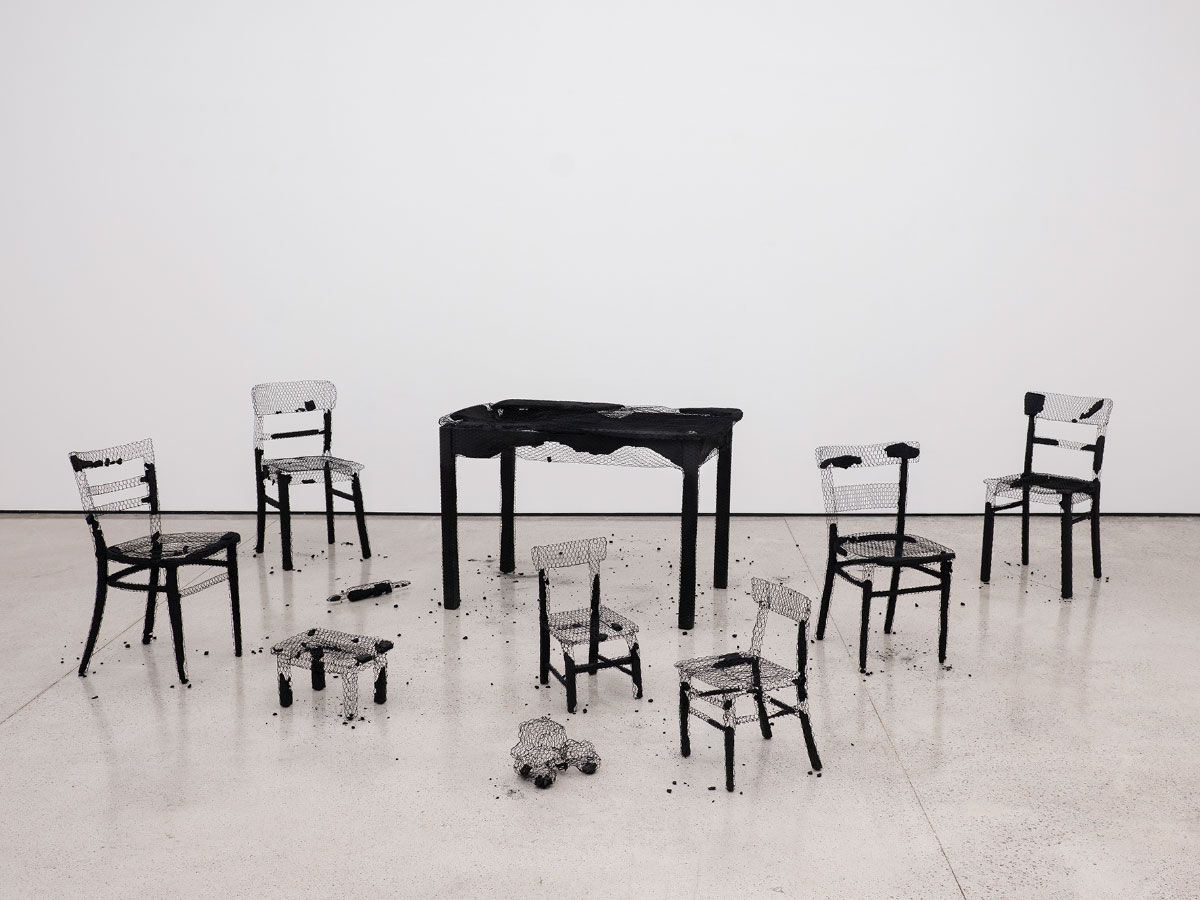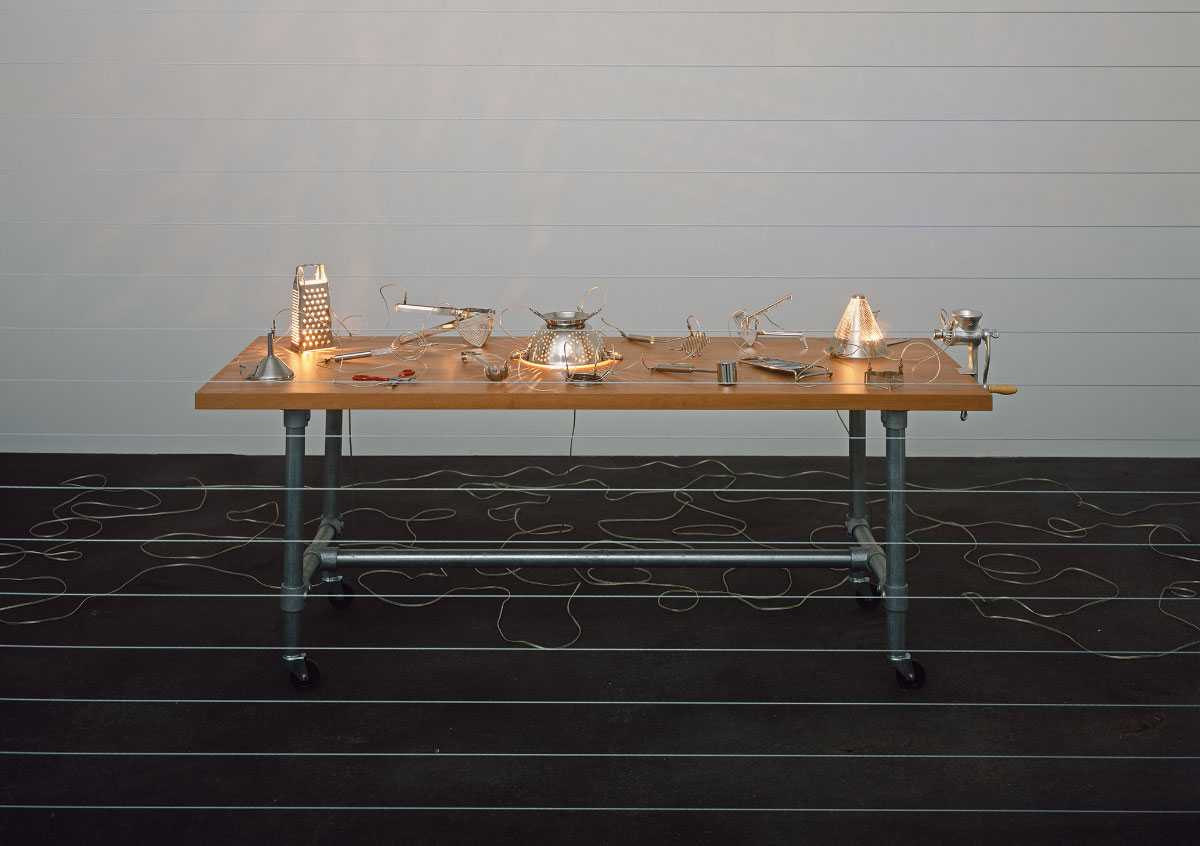PRESENTATION: Mona Hatoum
 Mona Hatoum creates discomforting, challenging work that reveals the contradictions and uncertainties of our complex, confounding world. Using domestic and other familiar objects, Hatoum creates installations and sculptures that may simultaneously evoke fear and fascination, or beauty and revulsion, and that could hardly be more pertinent to our era of global migration and political uncertainty.
Mona Hatoum creates discomforting, challenging work that reveals the contradictions and uncertainties of our complex, confounding world. Using domestic and other familiar objects, Hatoum creates installations and sculptures that may simultaneously evoke fear and fascination, or beauty and revulsion, and that could hardly be more pertinent to our era of global migration and political uncertainty.
By Dimitris Lempesis
Photo: N.B.K. Archive
With the exhibition “Mona Hatoum”, three Berlin institutions present the multifaceted work of Mona Hatoum. The exhibition at n.b.k. focuses on Hatoum’s dealings with the physical and psychological implications of structural repression through both domestic scenes as well as global scenarios. Her works address experiences of uprootedness – whether as a dissociative moment, trauma, or empowerment. Her ambiguous treatment of notions of home, gender roles and human vulnerability is a compelling artistic contribution to today’s pressing issues. The works presented at n.b.k. explore a state of existential uncertainty that Hatoum has called the “basic human condition of exile”. In installations such as “Home” (1999) or “Mobile Home II” (2006), objects from the domestic sphere are assembled into environments of potential threat. By turning kitchen utensils into buzzing conductors of a high voltage electric current and setting furniture in motion using kinetic processes, Hatoum questions the notion of “home sweet home” as a safe and stable place. “Home” consists of a long table covered with gleaming metal kitchen appliances. The table has a polished wooden top and heavy metal legs on wheels. The industrial connotations of the table are offset by the domestic kitchen utensils on its surface, including graters, scissors, a colander, a whisk, a ladle, salad servers, a sieve, a pasta maker, presses and a heart-shaped pastry cutter. Wires snake through the installation, connected to each utensil with crocodile clips. The wires conduct electrical currents to the objects periodically illuminating small light bulbs positioned beneath the sieve and colander and inside an upright grater. The current is controlled by a software programme that alters the frequency and intensity of the lights. Speakers amplify the crackling sound of electricity coursing through the wires and the metal objects. The sculpture is set back behind a barrier of thin horizontal steel wires that separates the viewer from the potentially lethal current. Hatoum appropriates objects related to the domestic kitchen, traditionally a feminine domain, and gives them a menacing, uncanny edge. The work’s title expresses an ironic, ambivalent relationship to the safe, nurturing environment that the word home implies. The artist has explained, “I called it Home, because I see it as a work that shatters notions of the wholesomeness of the home environment, the household, and the domain where the feminine resides. Having always had an ambiguous relationship with notions of home, family, and the nurturing that is expected out of this situation, I often like to introduce a physical or psychological disturbance to contradict those expectations”. In “Mobile Home II” furniture and other domestic objects are in perpetual motion within in a space defined by two barriers. Their movement produces a subtly unnerving, deeply meaningful yet playful effect. This work was partially inspired by the artist’s visits to Venice during the planning of her participation in the Biennale.
The artist also makes targeted use of cartographic systems to address zones of conflict, shifting borders and the precariousness of our planet. While Hatoum’s “Hot Spot III” (2009), a globe outlined in bright red lines, depicts the whole world as a spot of conflict and unrest, her 3-D “Cities” (2008–2010) refer to the fragility of urban landscapes in war zones. In the latter, maps of Baghdad, Beirut and Kabul, are presented on wooden trestles, with cut-out sections suggesting the constant cycle of destruction and reconstruction in cities impacted by war. In scrutinising the influence of state control on border demarcations and mobility, Hatoum touches on current debates on surveillance technologies and new forms of biopolitics. At KINDL – Centre for Contemporary Art, Mona Hatoum developed “Kesselhaus”, an expansive, kinetic, site-specific installation that takes advantage of the towering height of the historic boiler house (Kesselhaus). The installation consists of a tall, gridded structure resembling the frame of a building in a state of construction or deconstruction. Hatoum’s work makes reference to the upheavals of the present and our precarious and shaky existence – witnessing the collapse of prevailing systems and attempts for renewal and reconstruction.
Mona Hatoum’s extensive oeuvre, which includes sculpture, installation, video, performance, and works on paper, makes tangible the fragility of human life amidst ongoing societal changes. Hatoum’s intensive engagement with themes such as migration, exile, and governmental control is inseparably intertwined with her own biography. She was born in Beirut in 1952, as a child to palaestinian parents. When she traveled to London for a short visit in 1975, a civil war broke out in Lebanon, and she was denied re-entry into her home country. Presently, Hatoum lives and works in London and Berlin, and is regarded as one of the most influential artists of her generation. Since the 1990s, Hatoum has been incorporating a plethora of materials in her works, which, through a subtle play with contradictions, are bestowed with a latent air of jeopardy and irritation. With their clear formal language and the shiny surfaces of industrial materials, the works are influenced by the reduced aesthetic of minimal art – yet, the notion of performativity and, in close relation to that, the relationship to the body play an important part in them. In her more recent works, Hatoum dedicates herself to the exploration of precarious states in a globalized world. In expansive sculptural installations, she employs elemental shapes that on the one hand suggest order and stability, and on the other the potential of a sudden collapse. On a tightrope walk, and oscillating between stability and a sudden breakdown, between the familiar and the uncomfortable, between beauty and horror, the works offer a commentary on conflicting emotions and situations that the human psyche is subjected to in a reality defined by power political struggles.
Photo: Mona Hatoum, Remains of the Day, 2016–2018, Wire mesh and wood, dimensions variable, © Mona Hatoum, Foto / Photo: © White Cube (Kitmin Lee)
Info: Curators: Marius Babias, Kathrin Becker, Julia Wallner, N.B.K. (Neuer Berliner Kunstverein), Chausseestrasse 128 / 129, Berlin, Germany, Duration: 15/9-13/11/2022, Days & Hours: Tue-Wed & Fri-Sun 12:00-18:00, Thu 12:00-20:00, www.nbk.org/ , Georg Kolbe Museum, Sensburger Allee 25, Berlin, Germany, Duration: 15/92022-8/1/2023, Days & Hours: Mon-Sun 10:00-18:00, https://georg-kolbe-museum.de/ & KINDL – Centre for Contemporary Art, Am Sudhaus 3, Berlin, Germany, Duration: 18/92022-14/5/2023, Days & Hours: Wed 12:00-20:00, Thu-Sun 12:00-18:00, www.kindl-berlin.com/





Right: Mona Hatoum, Nail Necklace, 2018, Nails and hair on wooden bust, 26 x 20 x 14 cm, © Mona Hatoum, Foto / Photo: © White Cube (Ollie Hammick)


